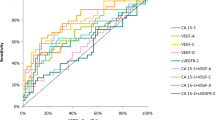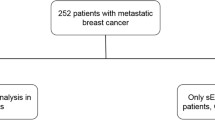Abstract
Transforming growth factor-beta1 (TGF-beta1) is a biomarker associated with the progression of breast cancer, characteristic by switching activity from tumor suppressor in early stages to tumor promoter at advanced disease. However, what cause this switch is still not clear. On the other hand, the relationship between steroid receptors (estrogen ER and progesterone PR) as the major discriminators of breast cancer phenotype and this paradoxical biomarker is not fully determined. In this pilot study on 52 breast cancer patients, quantitative plasma values of TGF-beta1 were determined by quantitative ELISA and steroid receptor content was measured in cytosol fraction of breast cancer tissue using dextran-coated (DCC) method. We tried to investigate the possibility that steroid receptor status of patients at different stages of disease could be the trigger that somehow causes variation of TGF-beta1 plasma levels. In nonmetastatic breast cancer patients, there was no statistically significant increase in the plasma levels of TGF-beta1, when patients are stratified by steroid receptor status (ER− vs. ER+, PR− vs. PR+). We found for the first time, that indeed in metastatic breast cancer statistically significant elevated levels of TGF-beta1 are related to negative steroid receptor status and moreover that, there is correlation between quantitative values of these parameters in this stage. This finding deserves further investigation because it could provide a new insight into more aggressive nature of steroid receptor negative tumors.

Similar content being viewed by others
References
Travers MT, Barrett-Lee PJ, Berger U et al (1988) Growth factor expression in normal, benign, and malignant breast tissue. Br Med J 296:1621–1624
Gorsch SM, Memoli VA, Stukel TA et al (1992) Immunohistochemical staining for transforming growth factor-beta1 associates with disease progression in human breast cancer. Cancer Res 52:6949–6952
Dalal BI, Keown PA, Greenberg AH (1993) Immunocytochemical localization of secreted transforming growth factor-ß1 to the advancing edges of primary tumors and to lymph node metastases of human mammary carcinoma. Am J Pathol 143:381–389
Fukuchi M, Miyazaki T, Fukai Y et al (2004) Plasma level of transforming growth factor beta1 measured from the azygos vein predicts prognosis in patients with esophageal cancer. Clin Cancer Res 10:2738–2741
Coban S, Yuksel O, Kockar MS et al (2007) The significance of serum transforming growth factor beta 1 in detecting of gastric and colon cancers. Hepatogastroenterology 54:1472–1476
Narai S, Watanabe M, Hasegawa H et al (2002) Significance of transforming growth factor beta1 as a new tumor marker for colorectal cancer. Int J Cancer 97:508–511
McCune BK, Mullin BR, Flanders KC et al (1992) Localization of transforming growth factor-beta isotypes in lesions of the human breast. Human Pathol 23:3–20
Barrett-Lee P, Travers M, Luqmani Y et al (1990) Transcripts for transforming growth factors in human breast cancer: clinical correlates. Br J Cancer 61:612–617
Murray PA, Barrett-Lee P, Travers M et al (1993) The prognostic significance of transforming growth factors in human breast cancer. Br J Cancer 67:1408–1412
Butta A, MacLennan K, Flanders KC et al (1992) Induction of transforming growth factor ß1 in human breast cancer in vivo following tamoxifen treatment. Cancer Res 52:4261–4264
Dublin EA, Barnes DM, Wang DY et al (1993) TGF α and TGFß expression in mammary carcinoma. J Pathol 170:15–22
Godden J, Porteous C, George WD et al (1993) Bioassay of transforming growth factor-beta activity in acidic protein extracts from primary breast cancer specimens. Anticancer Res 13:427–431
Muraoka RS, Dumont N, Ritter CA et al (2002) Blockade of TGF-beta inhibits mammary tumor cell viability, migration, and metastases. J Clin Investig 109:1551–1559
Muraoka-Cook RS, Kurokawa H, Koh Y et al (2004) Conditional over-expression of active transforming growth factor ß accelerates metastases of transgenic mammary tumors. Cancer Res 64:9002–9011
Wakefield LM, Letterio JJ, Chen T et al (1995) Transforming growth factor-beta1 circulates in normal human plasma and is unchanged in advanced metastatic breast cancer. Clin Cancer Res 1:129–136
Sminia P, Barten AD, van Waarde MA et al (1998) Plasma transforming growth factor beta levels in breast cancer patients. Oncol Rep 5:485–488
Lebrecht A, Grimm C, Euller G et al (2004) Transforming growth factor beta 1 serum levels in patients with preinvasive and invasive lesions of the breast. Int J Biol Markers 19:236–239
Kong FM, Anscher MS, Murase T et al (1995) Elevated plasma transforming growth factor-beta 1 levels in breast cancer patients decrease after surgical removal of the tumor. Ann Surg 222:155–162
Sheen-Chen SM, Chen HS, Sheen CW et al (2001) Serum levels of transforming growth factor beta1 in patients with breast cancer. Arch Surg 136:937–940
Ghellal A, Li C, Hayes M, Byrne G et al (2000) Prognostic significance of TGF-beta1 and TGF-beta3 in human breast carcinoma. Anticancer Res 20:4413–4418
Grau AM, Wen W, Ramroopsingh DS et al (2008) Circulating transforming growth factor-beta-1 and breast cancer prognosis: results from the Shanghai Breast Cancer Study. Breast Cancer Res Treat 112:335–341
Ivanović V, Todorović-Raković N, Demajo M et al (2003) Elevated plasma levels of transforming growth factor-beta1 (TGF-beta1) in patients with advanced breast cancer: association with disease progression. Eur J Cancer 39:454–461
Reiss M, Barcellos-Hoff MH (1997) Transforming growth factor/beta in breast cancer. A working hypothesis. Breast Cancer Res Treat 45:81–95
Osborne CK (1998) Steroid receptors in breast cancer management. Breast Cancer Res Treat 51:227–238
Matsuda T, Yamamoto T, Muraguchi A et al (2001) Cross/talk between transforming growth factor-beta and estrogen receptor signaling through Smad. J Biol Chem 276:42908–42914
Wu L, Wu Y, Gathings B, Wan M et al (2003) Smad4 as a transcription corepressor for estrogen receptor alpha. J Biol Chem 278:15192–15200
Knabbe C, Lippman ME, Wakefield LM et al (1987) Evidence that transforming growth factor beta is a hormonally regulated negative growth factor in human breast cancer cells. Cell 48:417–428
Hering S, Surig D, Freystact D et al (1995) Regulation of transforming growth factor beta by sex steroids. Horm Metab Res 27:345–351
Ewan KB, Shyamala G, Ravani SA et al (2002) Latent TGF-ß activation in mammary gland: regulation by ovarian hormones affects ductal and alveolar proliferation. Am J Pathol 160:2081–2093
Todorović-Raković N (2005) TGF-beta1 could be a missing link in the interplay between ER and HER2 in breast cancer. Med Hypotheses 65:546–551
Ewan KB, Oketch-Rabah HA, Ravani SA et al (2005) Proliferation of estrogen receptor-alpha-positive mammary epithelial cells is restrained by transforming growth factor-beta1 in adult mice. Am J Pathol 167:409–417
Stoica A, Saceda M, Fakhro A et al (1997) The role of transforming growth factor-beta in the regulation of estrogen receptor expression in the MCF-7 breast cancer cell line. Endocrinology 139:1498–1505
Arteaga CL, Tandon AK, Von Hoff DD et al (1988) Transforming growth factor ß: potential autocrine growth inhibitor of estrogen receptor-negative human breast cancer cells. Cancer Res 48:3898–3904
Dickson RB, Bates SF, McManaway ME et al (1986) Characterization of estrogen responsive transforming activity in human breast cancer cell lines. Cancer Res 46:1707–1713
Acknowledgments
This work was supported by Grant No. 145018 “Molecular biomarkers of growth, invasiveness and metastasis in breast cancer: clinical and biological aspects” from the Ministry of Science and Environment Protection of Republic of Serbia.
Conflict of interest statement
The authors declare that they have no conflict of interest related to the publication of this manuscript.
Author information
Authors and Affiliations
Corresponding author
Rights and permissions
About this article
Cite this article
Todorović-Raković, N., Nešković-Konstantinović, Z. & Nikolić-Vukosavljević, D. Stage-related plasma values of transforming growth factor-beta1 are steroid receptors dependent. Clin Exp Med 9, 313–317 (2009). https://doi.org/10.1007/s10238-009-0055-z
Received:
Accepted:
Published:
Issue Date:
DOI: https://doi.org/10.1007/s10238-009-0055-z




